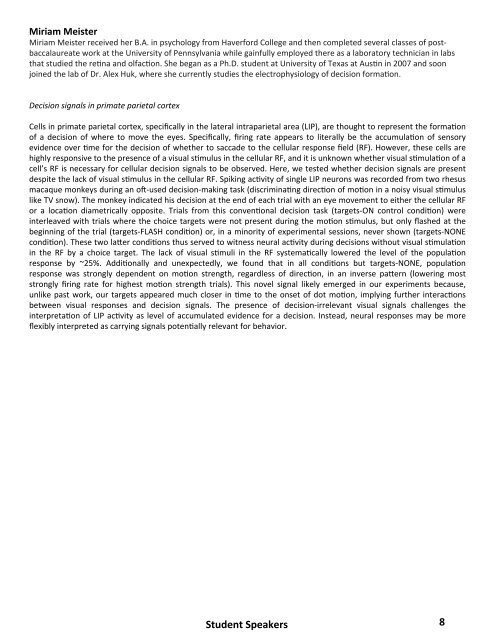Program - The Institute for Neuroscience - The University of Texas at ...
Program - The Institute for Neuroscience - The University of Texas at ...
Program - The Institute for Neuroscience - The University of Texas at ...
Create successful ePaper yourself
Turn your PDF publications into a flip-book with our unique Google optimized e-Paper software.
Miriam Meister<br />
Miriam Meister received her B.A. in psychology from Haver<strong>for</strong>d College and then completed several classes <strong>of</strong> post-‐<br />
baccalaure<strong>at</strong>e work <strong>at</strong> the <strong>University</strong> <strong>of</strong> Pennsylvania while gainfully employed there as a labor<strong>at</strong>ory technician in labs<br />
th<strong>at</strong> studied the re8na and olfac8on. She began as a Ph.D. student <strong>at</strong> <strong>University</strong> <strong>of</strong> <strong>Texas</strong> <strong>at</strong> Aus8n in 2007 and soon<br />
joined the lab <strong>of</strong> Dr. Alex Huk, where she currently studies the electrophysiology <strong>of</strong> decision <strong>for</strong>ma8on.<br />
Decision signals in prim<strong>at</strong>e parietal cortex<br />
Cells in prim<strong>at</strong>e parietal cortex, specifically in the l<strong>at</strong>eral intraparietal area (LIP), are thought to represent the <strong>for</strong>ma8on<br />
<strong>of</strong> a decision <strong>of</strong> where to move the eyes. Specifically, firing r<strong>at</strong>e appears to literally be the accumula8on <strong>of</strong> sensory<br />
evidence over 8me <strong>for</strong> the decision <strong>of</strong> whether to saccade to the cellular response field (RF). However, these cells are<br />
highly responsive to the presence <strong>of</strong> a visual s8mulus in the cellular RF, and it is unknown whether visual s8mula8on <strong>of</strong> a<br />
cell’s RF is necessary <strong>for</strong> cellular decision signals to be observed. Here, we tested whether decision signals are present<br />
despite the lack <strong>of</strong> visual s8mulus in the cellular RF. Spiking ac8vity <strong>of</strong> single LIP neurons was recorded from two rhesus<br />
macaque monkeys during an oB-‐used decision-‐making task (discrimina8ng direc8on <strong>of</strong> mo8on in a noisy visual s8mulus<br />
like TV snow). <strong>The</strong> monkey indic<strong>at</strong>ed his decision <strong>at</strong> the end <strong>of</strong> each trial with an eye movement to either the cellular RF<br />
or a loca8on diametrically opposite. Trials from this conven8onal decision task (targets-‐ON control condi8on) were<br />
interleaved with trials where the choice targets were not present during the mo8on s8mulus, but only flashed <strong>at</strong> the<br />
beginning <strong>of</strong> the trial (targets-‐FLASH condi8on) or, in a minority <strong>of</strong> experimental sessions, never shown (targets-‐NONE<br />
condi8on). <strong>The</strong>se two laEer condi8ons thus served to witness neural ac8vity during decisions without visual s8mula8on<br />
in the RF by a choice target. <strong>The</strong> lack <strong>of</strong> visual s8muli in the RF systema8cally lowered the level <strong>of</strong> the popula8on<br />
response by ~25%. Addi8onally and unexpectedly, we found th<strong>at</strong> in all condi8ons but targets-‐NONE, popula8on<br />
response was strongly dependent on mo8on strength, regardless <strong>of</strong> direc8on, in an inverse paEern (lowering most<br />
strongly firing r<strong>at</strong>e <strong>for</strong> highest mo8on strength trials). This novel signal likely emerged in our experiments because,<br />
unlike past work, our targets appeared much closer in 8me to the onset <strong>of</strong> dot mo8on, implying further interac8ons<br />
between visual responses and decision signals. <strong>The</strong> presence <strong>of</strong> decision-‐irrelevant visual signals challenges the<br />
interpreta8on <strong>of</strong> LIP ac8vity as level <strong>of</strong> accumul<strong>at</strong>ed evidence <strong>for</strong> a decision. Instead, neural responses may be more<br />
flexibly interpreted as carrying signals poten8ally relevant <strong>for</strong> behavior.<br />
Student Speakers<br />
8


